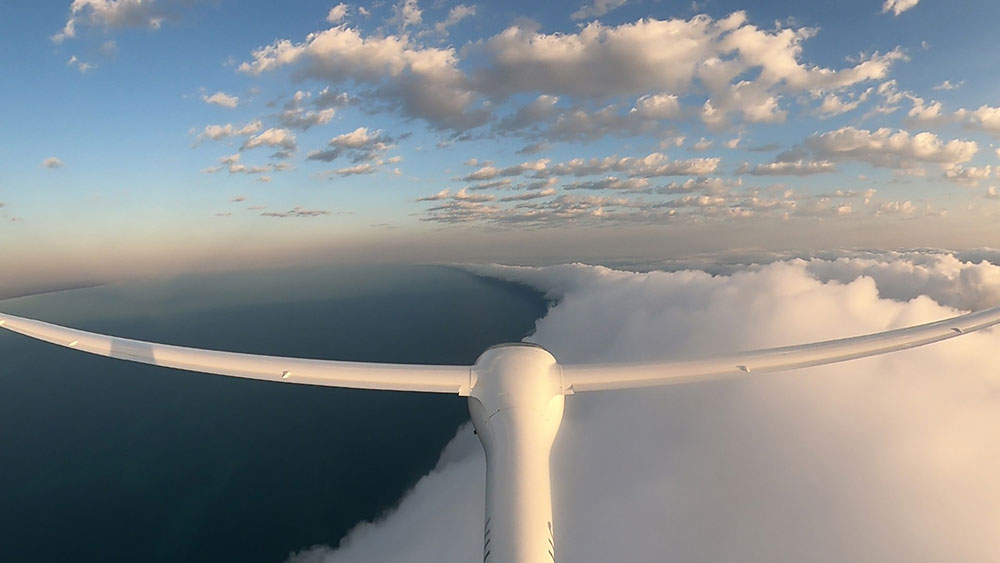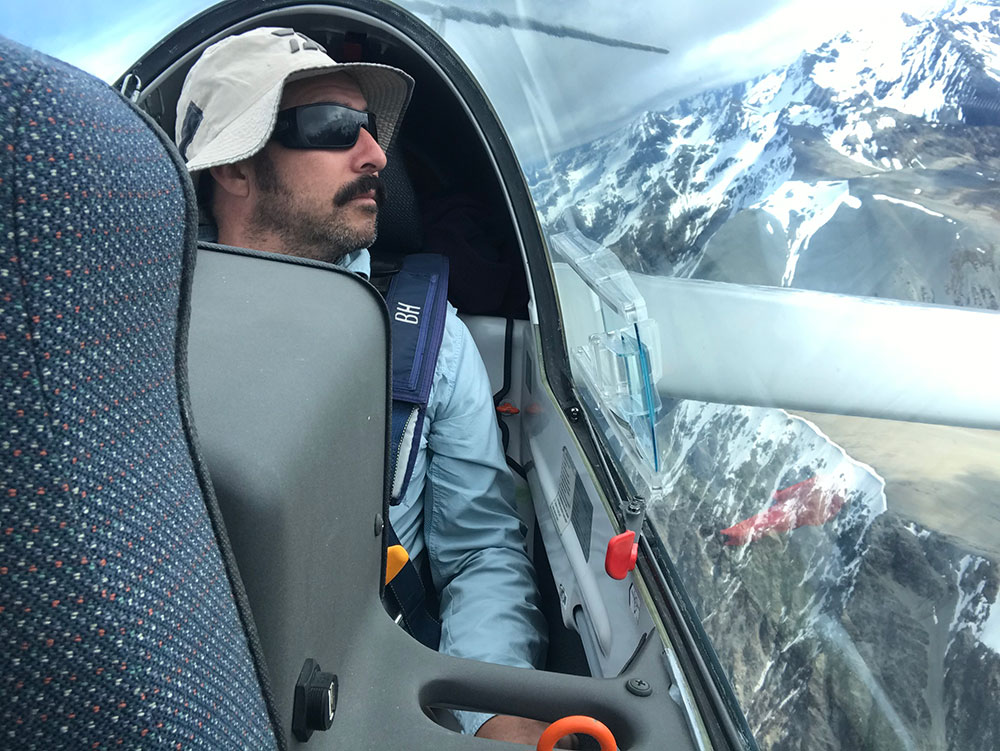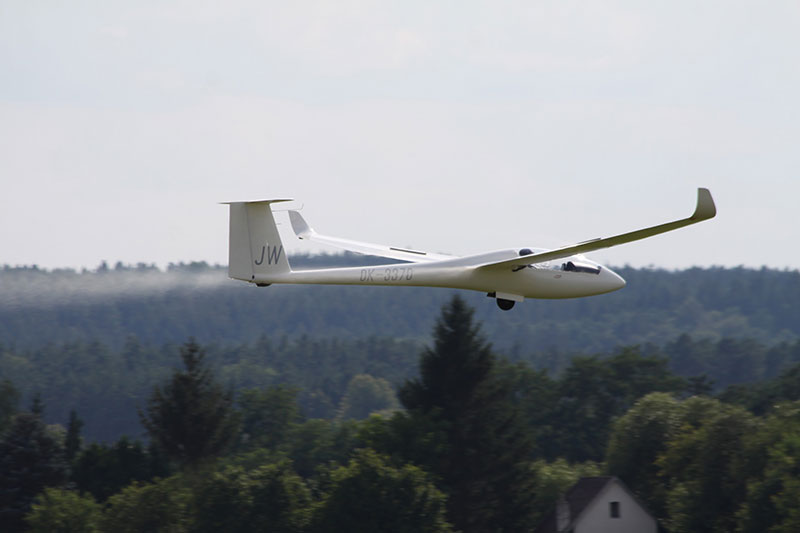All clubs and GFA members are urged to report all occurrences and incidents promptly, as and when they occur, using the GFA’s occurrence reporting portal at glidingaustralia.org/Log-In/log-in-soar.html. This is always best done while all details are fresh in everyone's mind.
You can read the full SOAR report at tinyurl.com/ltmko56
Reports noted 'Under investigation' are based on preliminary information received and may contain errors. Any errors in this summary will be corrected when the final report has been completed.
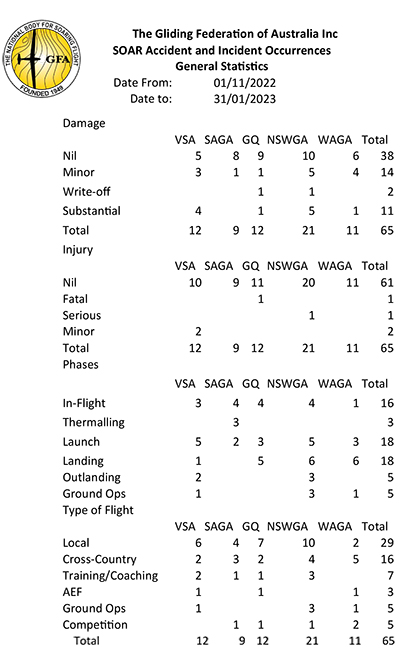
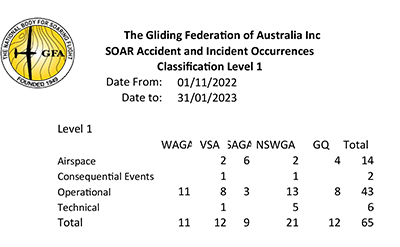
7-November-2022 SAGA
Discus-2cT
Airspace Infringement
What Happened
While thermalling to gain height before embarking on a cross country flight, the pilot allowed the glider to drift into restricted airspace. The pilot had launched into a thermal north of the airfield and drifted south due to northerly wind. While conscious of the glider’s proximity to the airspace boundary to the south of the airfield, the pilot became focussed on finding the core of the thermal and did not realise the glider had penetrated restricted airspace by 1NM. Upon reaching 6000 ft, the pilot proceeded on the planned Cross-Country flight and only identified the airspace breach upon reviewing the flight trace at the end of the flight. The pilot immediately reported the infraction.
Analysis
The aerodrome from which the pilot was operating is situated beneath Class C airspace (LL4500), and within and between several areas of restricted military airspace and Danger Areas. The Club has access to some restricted airspace by arrangement with the RAAF. The Club CFI advised that the pilot has a good understanding of Airspace and is normally very diligent not to infringe airspace. However, on this occasion the pilot lost situational awareness of the glider’s proximity to the restricted airspace while focused on finding the core of the thermal. As a result, it didn’t take long before the glider drifted across the boundary. The CFI noted that the boundary is not well defined by ground features, and an analysis of the Club’s database of airspace infringements has identified this boundary as being a common area for airspace infringements. The club has increased pilot awareness of the issue and runs regular airspace workshops that are well attended.
Safety Advice
To avoid airspace infringements pilots should apply Threat and Error Management in their flight planning and flying (e.g., identify the threats such as airspace, weather and equipment). Pilots must also consider the errors they are likely to make, such as in navigation, and address them early. Particular attention should be paid to vertical limits of controlled airspace, and pilots should plan to remain 200’ below the base of controlled airspace and/or 1nm from the edge whenever possible. An approved and up-to-date moving map display in the field of vision is useful, and ensure you carry a backup, whether a current paper chart with the route drawn on or a second moving map display. It is also important that pilots understand the role of distraction before and during flight and how it can lead to inadvertent infringement of controlled airspace. Pilots should consciously recognise distractions including those from passengers, unfamiliar equipment or its malfunction, aircraft problems or weather as well as personal problems or stress. Pilots should ensure they positively shift attention from them back to flying, operating, and navigating the aircraft. If weather is becoming a factor, change your plans early and carefully. Importantly, look outside the cockpit with
9-Nov-2022 GQ
Astir CS
Aircraft Separation
Under investigation
A powered aircraft listed with RAAus and an Astir CS glider were involved in a mid-air collision appoximately 2NMs South-West of Gympie aerodrome at a height of about 2,500ft. Both aircraft spiralled to the ground and their pilots were fatally injured. The accident is being investigated by the Qld Police and Coroner.
19-Nov-2022 GQ
Piper PA-25-235
Aircraft Separation
What Happened
A glider and tug combination on departure from the aerodrome and climbing out in a left-hand turn towards the north-west came within 800 metres horizontally and 200ft vertically of a recently solo and low hours pilot flying to the south-west upwind of the operational runway.
Analysis
This incident occurred on a busy day, with the club conducting training and aerobatics for aviation students from the Griffith University Soaring Society using three two-seat gliders and two tow planes. There was also some cross-country flying being conducted by experienced pilots. Just after midday, the recently solo pilot was launched by aerotow in the DG1000 for a local flight. Shortly afterwards, the Duo Discus was launched for an aerobatic flight, and the tow pilot was flying to the designated aerobatic area. The pilot of the tug towing the DG1000 positioned the combination over directly over the runway instead of upwind, and the glider pilot released at 2000ft in the general area where the aerobatic flights were being conducted. The pilot of the second tow plane TOWING THE Duo Discus reported that “There were lots of gliders in the air and there was a lot of cumulus cloud, so whilst visibility generally was good, gliders were hard to pick up against the very white sky. All aircraft have Flarms.” The second tow pilot conducted a standard departure and while climbing through 2000ft towards the aerobatic area, the command pilot in the Duo Discus sighted the DG1000 flying directly towards the towing combination from about 30 degrees to the right. The tug pilot did not see the glider. The pilot of the Duo Discus immediately released and made a radio call “turn left, turn left, turn left”. The tow pilot recognised the glider pilot’s voice and at the same time saw the glider release in the mirror. The tow pilot immediately turned left and descended. The pilot of the DG1000 saw the two aircraft in front at this time and simultaneously the aircraft FLARM alerted. Neither the tug pilot nor the pilot of the Duo Discus recalled receiving a FLARM alert. All aircraft separated, but the solo pilot was unsure of what to do and appeared to have continued straight flight ahead.
Safety Action
Following the flight, the CFI, who was also the pilot of the second tug, conducted a debriefing with all parties involved. The following causal factors were identified:
l Ability to spot aircraft was impaired by significant cloud.
l The solo pilot lacked experience operating in a complex and dynamic airspace.
l There was a general lack of understanding about where the aerobatic manoeuvres were being conducted.
l The Flarms in the Duo discus and Tow Plane may not have been serviceable.
l The collision beacon in the nose of the DG1000 was not turned on.
The club has since taken the following remedial action:
l A safety presentation emphasising lookout was presented to members.
l Procedure were implemented for coordinated operations during training programs, including supervision of early solo pilots in this environment.
l Formal procedures were established for the conduct of aerobatic flights to avoid conflict with gliders and transiting powered aircraft.
l The nose beacon in the DG1000 is required to be turned on in flight to increase visibility.
l All Flarms were checked for serviceability.
27-Nov-2022 VSA
EON Olympia Mk 2b
Terrain Collisions
What Happened
The pilot released from tow at about 2000ft AGL and found strong sink. The pilot turned back towards the aerodrome but rapidly ran out of height. The pilot elected to make a straight-in approach to a paddock about 1 km from the aerodrome but on late finals observed a powerline ahead. The pilot turned right to land in another paddock, but the glider's wing hit the ground during the turn and the glider struck the ground while travelling sideways. The forward fuselage suffered substantial damage and the tailskid was torn off. The pilot was uninjured and was driven back to the aerodrome by the farmer.
Analysis
The elderly pilot had about 500 hours aeronautical experience, of which 300 hours and 150 flights were in sailplanes. He had not flown for more than 12 months and completed six flights with the CFI as part of his Flight Review in the week preceding the accident. On the accident flight the pilot was flying a vintage Olympia sailplane that he had owned for several years and recently sold. The pilot’s experience on type was not provided. The pilot reported that after releasing from tow the glider encountered heavy sink and despite heading straight back to the aerodrome the glider did not fly into any lift. The pilot believed paddocks around the aerodrome were landable, so he continued to push on rather than select a closer paddock and conduct a circuit. On late final the pilot observed a powerline across the approach, and while manoeuvring at low level to land in another paddock the glider’s wing struck the ground. The glider slewed sideways and landed heavily and was substantially damage. The pilot was uninjured. The reason for the high sink rate was not established, and the glider’s airbrakes may have been extended for the flight.
Safety Advice - Outlanding
Accidents during outlanding are often due to not having enough time to thoroughly inspect and choose a field and plan the landing. The trap is when you keep hoping that you will find a thermal so you delay making the decision to land. Unlike landing at the home airfield where the runway layout, ground features and hazards are usually well known, when landing in a strange paddock the pilot is faced with the unknown. Such a situation demands the pilot take additional precautions to ensure a proper survey is undertaken of the landing area so as to identify all hazards and ensure a safe approach and landing can be accomplished. Pilots must adhere to their training, which requires the conduct of a proper circuit of the landing area to review for suitability.
Currency and Aging
It is well known that flight experience can compensate to some degree for age-related declines in cognitive function and that overlearned complex tasks such as piloting are less susceptible to age-related deterioration than abilities to perform in novel situations. Notwithstanding, recency of experience can have a dramatic effect on overall airmanship, regardless of age. It is known that older pilots who have long breaks between flying take longer to regain their proficiency. Older pilots should fly regularly and participate more frequently in recurrent training. Unfortunately in this case, the recent flight review was not sufficient to prevent this accident from happening.
29-Nov-2022 VSA
Piper PA-25-235/A1
Aircraft Control
What Happened
During the third aerotow for the day and at approximately 50ft AGL, the tug commenced an uncommanded rapid roll to the right resulting in the tug turning sharply to the right. The tug pilot released the tow rope and initiated an unusual attitude recovery. The glider pilot simultaneously released the tow rope and landed straight ahead. The tow pilot flew a modified circuit and landed.
Analysis
The launch was being conducted without the assistance of a wingtip runner, so the glider was taking off from a wing down position. The slack in the rope was taken up uneventfully and the combination became airborne. The tow pilot reported that shortly after becoming airborne and at a height of about 50ft, the tug “…went from straight and level to nearly 90 degrees within less than a second”. The pilot attempted to reduce power but inadvertently pulled the mixture control. Observing the glider passing on the left, the tow pilot pulled the release, and then applied full power to climb away. The glider pilot also released from tow and landed heavily straight ahead. The tow pilot completed a modified circuit and landed safely. The tug was inspected by a LAME and no issues or defects were identified. The glider was undamaged. The trace from the tug’s Flarm unit verified the pilot had sufficient airspeed at the time of the upset. The Club Tugmaster believes the occurrence was consistent with the tug having been caught by a thermal gust.
2-Dec-2022 NSWGA
DG-808 C
Aircraft Separation
Under investigation
Two gliders nearly collided in the circuit while landing on different runways. A DG 800 was on final approach to RWY 18 and a SZD 55 was in a left-hand circuit to RWY 09. The SZD 55 passed directly underneath the DG 800 with abut 60 feet vertical separation. The pilot of the SZD 55 did not see the DG 808 and was unaware of the incident until debriefed afterwards. The pilot of the DG 800 observed the SZD 55 low on the left and passing underneath and had no time to take avoiding action. Analysis of the flight traces revealed that both gliders had passed in opposing directions about 1 minute earlier when the DG 800 was on base leg to RWY18 and the SZD 55 was positioning to join downwind to RWY 09 in left-hand turn. At that time the gliders passed within 130 metres horizontal separation and 151 feet vertical separation. Neither pilot could recall receiving a Flarm alert of the near collision. Both pilots heard each other’s circuit calls, but the pilot of the SZD 55 was confused by the DG 800 pilot’s circuit call due to the expectation they would be landing on the common runway being used for landing on the day. The pilot of the SZD 55 was undertaking their first flight in type.
8-Dec-2022 NSWGA
Sparrow Hawk
Terrain Collisions
Under investigation
During the initial stages of an aerotow launch, and shortly after the glider became airborne, witnesses observed the glider move into the high tow position and, when at a height of about 50ft AGL, the glider was observed to suddenly pitch up steeply to the right, and then the left wing and nose dropped. One witness observed the tow rope was still attached as the glider pitched down but believed the pilot must have activated the tow release because the tow plane climbed away while the glider departed controlled flight. As the glider’s left wing dropped, the wingtip struck the ground followed by the fuselage striking the ground in a nose down attitude while pivoting around the wingtip. The glider was substantially damaged, and the pilot suffered serious injury. Police and emergency services attended, and the pilot was transported to hospital by ambulance. The pilot has no recollection of the launch or accident.
15-Dec-2022 NSWGA
Standard Cirrus
Aircraft Control
What Happened
During a competition flight the pilot conducted a straight-in approach from the control point approximately 10km from the finish circle. The pilot omitted to configure the aircraft for landing by lowering the undercarriage and did not complete the pre-landing checklist before landing.
Analysis
The pilot stated that he had earlier recovered from two potential outlandings and he may have been fatigued. Additionally, the pilot did not carry sufficient drinking water for the flight and may have also been dehydrated. The pilot also noted the undercarriage lever on the aircraft being flown acted opposite to what he was accustomed. Discussion with the CFI highlighted the importance of maintaining appropriate consideration of human factors in relation to the effects of dehydration, appropriate infight hydration, sustenance, urination, the cumulative effects of fatigue following multiple days of flying, including in hot conditions.
Safety Advice
Straight-in approaches are now commonly used to simplify the final approach under competition conditions. While they require more experience and energy management, they avoid complexity and exposure to collision risk. However, the chances of identifying an error while flying a normal, standard circuit is significantly higher than when on final glide for a straight-in approach. The absence of a base leg (particularly) but also of a downwind leg also reduces the opportunity to examine the landing area and final approach. Notwithstanding, none of this does more than add to workload and this procedure is, on balance, safer for experienced pilots. Despite this, landing mishaps still occur during a straight-in approach due to poor workload management, so pilots must take care to ensure that the pre-landing checklist is carried out. For further information, refer to OSB 01/14 'Circuit and Landing
17-Dec-2022 GQ
Cessna 150G
Aircraft Control
Under investigation
As the glider/tow aircraft combination was passing about 1500 feet, the tow aircraft received a drastic load pulling the tail to the left. The tow pilot checked the rear vision mirror and noted the glider in a position well to the left of the tow aircraft. As the tow pilot watched, the glider commenced a correctional turn to the right but at such a speed that the tow pilot became alarmed and decided to release the tow rope from the tow aircraft.
17-Dec-2022 WAGA
SZD-48-1 Jantar Standard 2
Preparation/Navigation
What Happened
During an aerotow launch, the glider pilot noticed a vibration at approximately 300 feet AGL and observed that the airbrakes were open. He promptly closed them and the flight continued.
Analysis
The pilot is very experienced and was carrying out his third flight for the season. At the time he thought he had an adequate time to conduct all his checks as the tug had just taken off. However, he did not realise that the second tug had started and was positioning in front ready for the tow, which caused him to rush through his checks to avoid holding up others awaiting to fly. Although he thought he had checked the airbrake, they were not locked. On review there did not seem to be a safety issue regarding the climb as the tug pilot did not notice any decrease in performance.
Safety Advice
Pilots must remain alert to the risks of rushing through checklists, as vital procedures can easily be missed. Checklists enhance flight safety and enable the pilot to confirm safety critical systems and controls are correctly and consistently configured for a phase of flight. Distractions, interruptions, and haste result in a disruption of the sequential flow of the checklist. One technique to counter distractions and interruptions is to repeat the entire checklist (starting from the beginning) during these situations. Unfortunately, if the pilot is in a hurry, this will likely not be done.
17-Dec-2022 VSA
Twin Astir
Aircraft Separation
What Happened
A winch launch was abandoned just before the launch commands were given as a powered aircraft flew over the runway at a height where conflict was likely. No radio calls were heard from the aircraft, that had departed a nearby certified aerodrome.
Analysis
A two-seat glider was about to be launched on a training flight when the launch crewman heard and then saw an aeroplane about to overfly the duty runway at a height that would likely conflict with the launch. The ground crewman immediately called “stop, stop, stop” to the member in the control van, who relayed the message to the winch driver. The launch did not proceed. Neither the ground nor flight crew heard a radio call from the aircraft to indicate a possible overfly of the glider field. The ground crewman made a broadcast to the aircraft overflying to the effect that it was overflying an active winch launching glider field but did not receive a response. The identity of the overflying aircraft could not be ascertained.
Safety Advice
The potential for conflict with transiting aircraft overflying operational winch sites is real, and there have been several close calls over recent years. It will be obvious to all that it is essential for pilots preparing to launch to be aware of any airspace activities in their vicinity and the threat, if any, posed by the presence of other aircraft. Lookout is the principal method for implementing see-and-avoid. Effective lookout means seeing what is 'out there' and assessing the information that is received before making an appropriate decision. The primary tool of alerted see-and-avoid that is common across aviation is the radio. Radio allows for the communication of information to the pilot from the ground or from other aircraft. Radio is also useful for the wing runner, to aid in situational awareness or monitoring of gliders or aircraft that might affect the launch operation. A radio announcement prior to each and every launch is a standard operating procedure at all gliding sites and is expected by other operators. With winch launching operations, Gliding Australia now requires all launch commands, including the ‘take-up slack’ and ‘all out’ commands, be given on the CTAF or local aerodrome frequency. These additional calls improve situational awareness for pilots flying in the area and are known to have been responsible for reducing conflict with transiting powered traffic at, at least, two winch sites in Australia. In this case the above requirements for ensuring the airspace was clear for launch was clearly understood by duty crew on the day, and their alertness prevented a potential accident.
26-Dec-2022 NSWGA
Discus-2b
Terrain Collisions
Under investigation
During a cross-country flight the pilot flew across unlandable terrain in search of lift marked by clouds. When the pilot arrived under the clouds, he was unable to find lift, and the glider became too low to fly to suitable landing areas. While attempting to land on a highway, the glider undershot and crash into scrubland. The glider was substantially damaged but the pilot was uninjured.





























